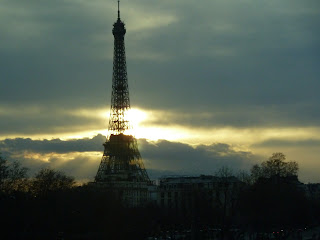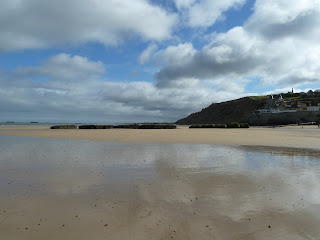Our next stop was Omaha beach - site of an American D-Day invasion. We trekked down to the beach, where the waters of the English Channel were glistening in some momentary sunshine. The beach was beautiful and it was hard to remember that such an exceptionally gorgeous place was the site of such great destruction. We were soon reminded of the somber meaning of the beach as we ascended the sandy mount and toured the American Cemetery. Over 9000 graves of American soldiers were lined up in perfect precision. Each deceased seemed to remain a soldier in death: lined up in battalions, each just another addition to the great number of casualties generated by the war.
 |
| Exploring a bomb crater at Pointe du Hoc |
Pointe du Hoc, situated above the sea on the Normandy coast, was the site of the US attacks on German troops during Operation Overlord. Pointe du Hoc towered over the ocean, the landscape broken up by huge bomb craters, and remnants of German fortifications. We got our fill of crawling in and out of barracks, and for some, mud sliding down into the craters, and then departed for Bretagne.
 |
| Apple-Caramel Crepe |
We walked around the winding, village-like streets of Saint Malo and stopped for dinner at a creperie. Crepes, specifically gallettes - crepes made with ble noir (buckwheat flour) - originated from this region. Our whole group feasted on sparkling cider (also a local product), savory gallettes and sweet dessert crepes of all kinds - a delicious exploration into Breton cuisine. I tried a gallette with duck, potatoes and cheese, and a crepe with apples and salted butter caramel. Yum.
 |
| Saint Malo |
 |
| Mont Saint-Michel |
Our sadness disappeared when we arrived at Mont-Saint-Michel. The beautiful Medieval fortress, become monastery, is atop a tall, hilly island and is perched over the ocean.
We climbed the many stairs up to the abbey - the building itself had gorgeous architectural details, and the views from all the levels and rooms were astounding.
We meandered our way back down the chateau, through windy streets crowded with gift shops and cookie vendors. With some souvenirs, a camera full of pictures and sore feet, we headed back home to Paris. As we approached the city, Paris welcomed us back with a beautiful sunset shining behind the Eiffel Tower.
 |
| Back home in Paris |


No comments:
Post a Comment